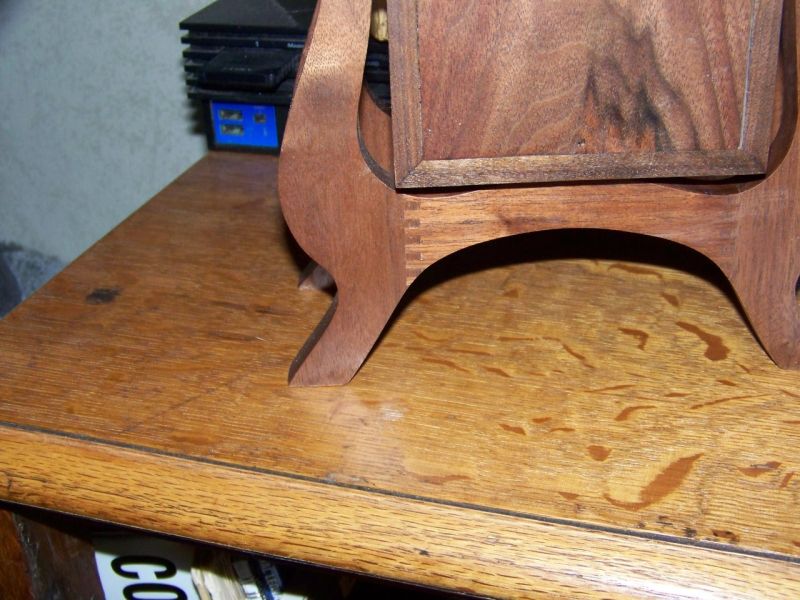Why Did a Finger Joint Break?
Woodworkers diagnose a broken joint and suggest repair strategies. March 28, 2012
Question
After almost completing the small project below the finger joint broke left of the fingers along the grain of the upright piece. It is only about an inch long so not a lot of strength. I am looking for ideas on how to strengthen it without being too evasive.

Click here for higher quality, full size image
Forum Responses
(Furniture Making Forum)
From contributor G:
It looks like you have the grain running in opposite directions. On a small piece this shouldn’t be much of a concern and I think you could strengthen the joint using a dowel or two, inserted before you glue up. Thus it would be invisible, or you could dowel afterwards and blend it in or contrast it (pillowed or chamfered ends). A tenen joint also comes to mind.
From contributor J:
The pic is too small and blurry to see what's happening there with any confidence, but it does look like the grain of the piece on the left is going in the wrong direction for a finger joint. I'm guessing you need to use an entirely different sort of joint, probably some variation on M&T.
From the original questioner:
I know there is a cross grain situation here, it is a small item. As I said in my original post it is only approximately an inch long so expansion should not be a problem. Moving away from a finger joint takes away from the whole design so it needs to stay. This is just a prototype and I will make changes as I progress to the finished product.
From contributor D:
You could pilot a longish screw centered from the underside into the legs. You can re-shape the area where it broke past the area , equally on both sides to hide any break. Maybe if your layout was opposite for the fingers you could have avoided the short grain at that location.
From contributor J:
One or two small dowels would be a fine way to go. Structurally speaking, this is a misuse of a finger joint. Not because of cross-grain movement issues but because the short grain across the fingers is very weak. Treat the finger joints as completely decorative and add something else for structure, and it should be fine.
From contributor O:
You misunderstand the purpose and use of the finger joint. There is no strength from 50% of your joint. Good joinery works with the grain of the wood. You are joining two pieces of wood at right angles (grain-wise). This is an application for mortise and tenon, dowel, spline or similar right-angle joinery solutions. The finger joint is used to butt join two end grain pieces together as in to make a longer piece of wood, to join at ends, say for a circular or octagonal frame, or vertically for a box joint. Look at historical grain situations like yours and see what works over time.
From contributor P:
I agree with Contributor O. This is no place for a box joint. In my opinion the joint degrades you piece by distracting the eye. Hardly a design feature but more like stuck on decoration. It must have taken some careful work to make the joint but it is doomed to fail and should be changed.
From the original questioner:
The box joint here is solely decorative. That's why the original question was how to strengthen it without being evasive.
From contributor C:
"The box joint here is solely decorative." Then, exactly why did it break? Why do you need to strengthen a "solely decorative" joint?
From the original questioner:
It’s a prototype. I took the round wheel out of the square box to see if it would roll. I guess it won't roll, maybe I will wrap plywood with veneer and call it good.
From contributor G:
Don't give up. As an alternative, a dovetail would look good and be appropriate for this application. The tail would go in the horizontal member and the pin in the vertical. The pin doesn’t even have to be tapered since there are no forces on the joint that require it in this situation. This would be as easy to machine as the box joint fingers. It is true that the “joinery” distracts the eye and is not a necessary for structural strength; a simple dowel will do just as well just without the looks.
From contributor Y:
I agree with the other comments, however if you insist on using the finger joint as shown, a simple solution is to make the finger joint first, then add a loose tenon-type mortise and tenon which would give the traditional M&T strength for this joint as long as the loose tenon goes deep well past the finger joints.
From Gene Wengert, forum technical advisor:
The problem with the joint as you designed it is that the fingers are blunt and so there are some sharp corners. The stress will concentrate at these corners. That is why it is the typical finger joint, the fingers taper and are rounded at the top and in the valleys. In addition, as mentioned, the cuts in the vertical piece are very weak, as wood is weak in splitting along the grain. A dowel is a good approach indeed.
